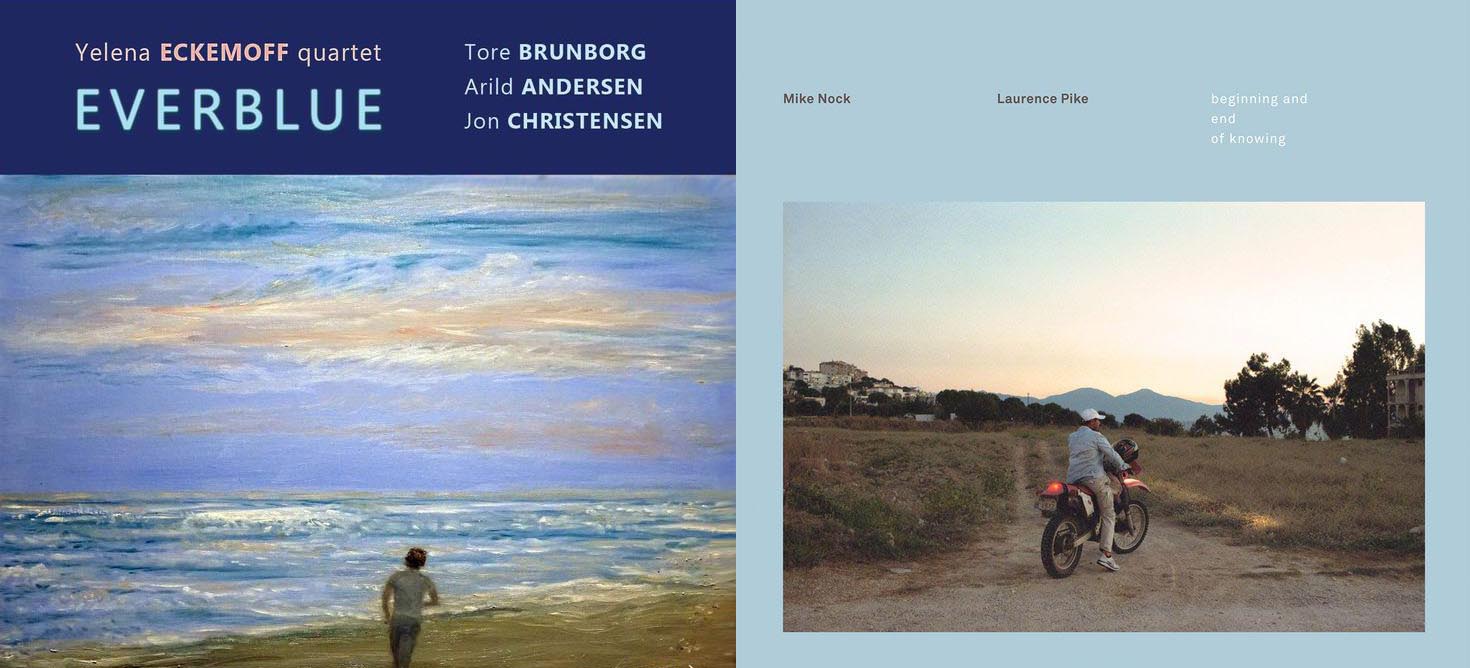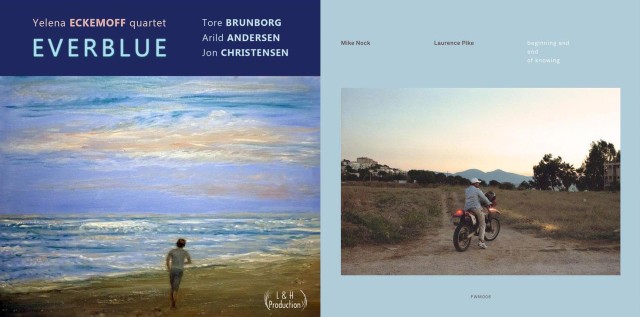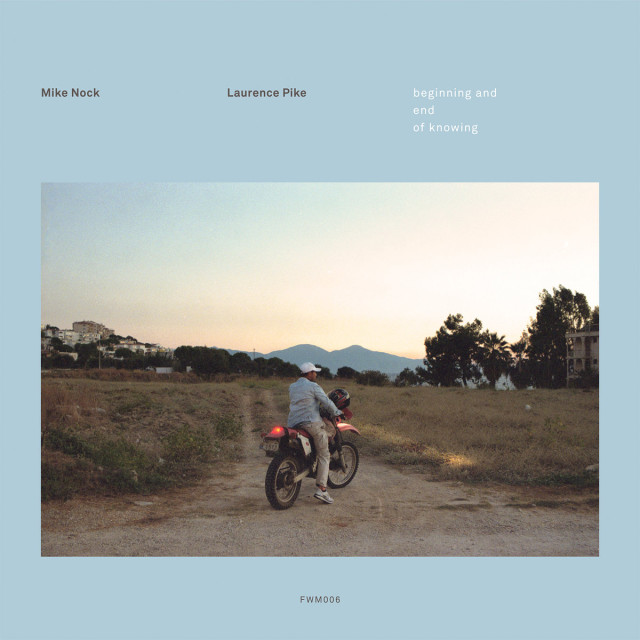Album review by Neil Hobkirk
When is an ECM album not an ECM album? Two new releases from, respectively, Yelena Eckemoff and Mike Nock/Laurence Pike provide compelling answers.
The question’s not so nonsensical as it seems. Notwithstanding dozens of ECM albums recorded down the decades in NYC—by, among others, Art Ensemble of Chicago, Jack DeJohnette’s Special Edition, Tim Berne’s Snakeoil, the Billy Hart Quartet and the Dave Holland Quintet—as well as many more recorded elsewhere, the characteristic ECM “sound” has long been identified with sessions engineered in Oslo by Jan Erik Kongshaug. Since 1970 the man’s been imparting to ECM’s Oslo productions a delicately atmospheric ambience revelatory of the finest musical details. To this day, hundreds of the German label’s offerings have been blessed by his attentiveness. But also to this day, Kongshaug has continued to finesse sessions for independent producers and other labels; it’s not solely producer Manfred Eicher’s ECM that’s benefitted from this sublimely resonant yet austere studio sound.
Soviet Russian-born Yelena Eckemoff journeyed to Kongshaug’s Rainbow Studio in September 2014 to record the masterful Everblue (2015). Since trading the Soviet Union for the United States, this conservatory-trained composer and pianist has increasingly channelled her artistry into musical projects embracing improvised elements and jazz instrumentation. Starting in 2009, Eckemoff’s released eight self-produced jazz records where she keeps impressively heavy company: drummers Billy Hart and Peter Erskine; bassists Mads Vinding and George Mraz; saxophonist Mark Turner; and vibist Joe Locke, among others. Reportedly she has at least two further sessions already in the can: one featuring violinist Mark Feldman; the other, reedist Paul McCandless. Yes, heavy company.
In interviews Yelena Eckemoff has professed an affinity for players identified with the ECM aesthetic. Everblue mines this affinity not only by enlisting Jan Erik Kongshaug’s services but also by convening a quartet that includes three ECM stalwarts: bassist Arild Andersen, drummer Jon Christensen and saxophonist Tore Brunborg. Christensen’s long been considered house drummer for Eicher’s Oslo productions, and he and Andersen appeared as members of the Jan Garbarek Quartet on Afric Pepperbird in 1970—their earliest ECM appearance, and Kongshaug’s first engineering credit for the label. Besides sideman work, Arild Andersen has contributed fascinatingly varied leader dates to ECM, including the recent Mira (2014), recorded at Rainbow in 2012. Along with Andersen and Christensen, tenorist Tore Brunborg played on Masqualero’s three 80s/90s ECM releases, and recently he’s made his mark on dates led by celebrated ECM pianist Tord Gustavsen.
On Everblue Eckemoff proves a bandleader of similar stripe, sharing Gustavsen’s preference for downtempo watercolour impressionism. But while Tord Gustavsen’s music highlights his soulful keyboard improvising, hers affirms her skilful composing. Ms. Eckemoff considers herself first and foremost a composer; the piano, a vehicle primarily for recording her compositions and only secondarily for improvising and live performing. Apparently she knows her strengths and weaknesses well enough to capitalize on them: with each successive record Eckemoff’s made an incrementally stronger case for staying studio-bound and performing rarely; the albums keep on coming, better and better.
In the case of Everblue, witness an album composer-driven yet admissive of collaborators’ idiosyncrasies. Interviewed in 2012, our composer revealed that she’s trying to ease up, leaving more room in her pieces for performers to stretch out improvisationally and become co-creators (JazzTimes). On Everblue, Eckemoff’s studio perfectionism fully embraces the elemental instincts of her Norwegian sidemen. The result? A lovingly detailed soundscape and an audiophile’s delight—and a Rainbow Studio production worthy of the august German label it wasn’t issued on!
This remarkable record opens sea-evokingly with the title piece. Like the other nine tracks’, “Everblue”s waters at first seem placid, but Eckemoff’s intrepid sidemen animate them with countless moving parts—currents and countercurrents that trouble the tranquil surface. The first minute finds Ms. Eckemoff traversing her keyboard unhurriedly, with sublime lightness of touch. Then the rest enter, tenor keening imploringly over the rhythm tandem’s subtle rumble. With his pinched yet sensuous delicacy, Brunborg brings to mind ECM sax star Jan Garbarek, but the younger man nonetheless displays his own voice. Andersen’s and Christensen’s contributions are likewise distinctive, the bassist projecting massively during his solo (at 3:50), the drummer focusing mostly on brushes and snare until the end, where thickening cymbal textures usher the tune out.
“Skyline” sounds similarly understated, opening in offhand fashion with piano and sax. Gentle stirrings from bass, snare and cymbals haunt this soundscape, which becomes a vehicle for Brunborg’s preoccupied musings. Behind him Eckemoff and Andersen intertwine closely before embarking on brief, sharply etched solos. Closing piece “Blue Lamp” too capitalizes on understatement, its crystalline piano intro showing the way to a simple soprano sax statement. Eckemoff and Brunborg continue to share melodic ideas against Andersen’s steady pulse and Christensen’s cymbal rustlings and sustained brushwork. The tune—and the album—ends with serenely ascending piano notes in the upper register.
Everblue’s other tracks are more moody and restless. “All That Is, Seen and Unseen” starts broodingly before (at 1:18) Eckemoff dispatches a brightly classical-sounding solo highlighting crisp left-hand counterpoint. Raising a gentle racket, Christensen concentrates almost wholly on cymbals, with only the briefest mid-tune tom interjection capping a melodic climax by Brunborg. From this point piano and cymbals hold sway for a spellbound stretch until bass kicks back in, turning the piece in a distinct new direction.
Throughout this record, Jon Christensen’s the wild card. Watch the YouTube video for the “All That Is” recording session and you’ll witness him striking cymbals that sit directly on his floor tom and snare drum. On “Ghost of the Dunes” his approach is similarly unconventional, involving cymbals and bass drum only. Moreover the video for this piece shows him addressing the drum with stick rather than pedal. 1970s ECM records reveal Christensen as a distinctively delicate stylist, accompanying artists like Ralph Towner (Solstice, 1975) and Keith Jarrett (Belonging, 1974; My Song, 1978). But by the time of Everblue, the man’s technique has evolved into something uniquely unorthodox, at odds with conventional notions of rhythmic timekeeping. Avant-gardist Tony Oxley comes to mind as a point of percussive comparison.
On recent Rainbow-recorded discs such as Jakob Bro’s Gefion (ECM; recorded 2013) and Ketil Bjornstad’s Remembrance (ECM; rec. 2009)—where he cohabits Bjornstad’s trio with Tore Brunborg—Christensen’s technique seems refined to its minimalist max, setting a precedent for Everblue’s spare drumming and against-the-beat cymbal exclamations. All Christensen’s chatterings and rustlings result in a forest floor’s worth of crepitant detail. Meanwhile Andersen’s bass niggles, nuzzles, prods and propels; Brunborg’s saxophone worries, importunes and lightly admonishes. At the centre of this woodland hubbub sits Eckemoff’s piano, seldom urgent yet ever authoritative.
Leading from the keyboard, Ms. Eckemoff animates “Ghost of the Dunes” dramatically, embellishing the haunted landscape with trills and even (at 1:47) releasing a series of sour exclamatory notes that would sound at home in some Soviet-era piano work—Shostakovich’s Piano Trio No. 2, say. Eckemoff’s crisply patrician pianism meshes intriguingly with Christensen’s random bass-drum rumbles and cymbal strikes tangential to the music’s flow. Fused together by Brunborg’s calm melodicism and Andersen’s earthy insistence, these disparate elements dovetail delightfully.
The moodiest of mood pieces, “Abyss” reveals itself through darkly intertwined piano and bass. Captured by Kongshaug’s microphones, Andersen’s and Eckemoff’s instruments resonate richly; and when Brunborg enters raptly (at 1:20), his tenor registers with palpable tenderness. Guiding an ominous melody, the keyboard unfurls a pitch-black panorama illuminated by cymbal crashes like sudden dazzling jellyfish. Christensen in fact restricts himself to cymbals here, not once addressing a drum. A representative Eckemoff composition, “Abyss” is carefully structured to withhold unequivocal emotional weight: throughout, a full-blown romantic melody tries to surface but emerges from the deep only in glimpses. Even at their sunniest, as in “Sea-Breeze” and “Waves & Shells,” Ms. Eckemoff’s pieces intimate the prospect of clouds.
Testifying to a strong working relationship, Everblue’s other two pieces are Andersen’s—the first non-Eckemoffs on an Eckemoff record. By now, on his third sideman appearance for the pianist, Arild Andersen has clearly grown conversant in her musical dialect. From his own ECM trio date The Triangle (2004) the bassist adapts “Prism” to the purposes of Eckemoff’s quartet. Matters open in Andersen’s own hands with a brief, winding bass solo. Immediately all the tune’s elements sound recognizably of a piece with Eckemoff’s Everblue world. There’s the shyly beautiful melodic content, uncommitted to direct statement. There’s Christensen’s companionable clatter and Brunborg’s whispery diffidence (on soprano this time). And of course there’s Eckemoff’s painterly pianism, limning a gently eventful aquarelle. (A video for “Prism” too appears on YouTube.) Titled “Man,” Andersen’s other contribution is a comparatively knotty tune, with Eckemoff dispensing dense keyboard contrapuntalism, Christensen addressing toms to bold effect, and Brunborg on tenor breathily embroidering the urbane main theme. For his part, the composer scrapes wailing complaints from his strings, introducing the most punchily assertive—the “manliest”?—track on the album.
Given the musical synergy on display, it’s appropriate that Everblue’s album cover bills the band as the Yelena Eckemoff Quartet. But despite the collaborative spirit that infuses Eckemoff’s record, hers is not a working group. The Mike Nock/Laurence Pike duo, on the other hand, is. Beginning and End of Knowing (2015) is their second record—following Kindred (2012)—and this Australian piano/drums project is a gigging concern, playing wholly improvised shows that match their wholly improvised approach at recording sessions.
To record Beginning and End of Knowing over two days in 2015, producer Pike arranged for the pair to visit Rainbow Studio. Like Yelena Eckemoff an admirer of the ECM aesthetic, Pike judged Jan Erik Kongshaug’s coolly Nordic studio sound appropriate for his Antipodean duo with Nock. And the ECMblance doesn’t stop at recording quality; the album’s cover follows the design typical of ECM’s 1980s releases. See the front cover of John Surman and Jack Dejohnette’s The Amazing Adventures of Simon Simon (1981) for comparison.
Independently produced, the new Nock/Pike disc appears on FWM (Fourth Way Music) Records, named after Nock’s ‘60s/’70s U.S.-based fusion group The Fourth Way. The veteran Australian pianist, now 75, is himself intimate with the particulars of record production. From 1996 to 2001 he acted as music director of Naxos Jazz, the sadly defunct Naxos imprint for which he oversaw production of over 60 CDs representing a truly international artist roster. I’m personally a big fan of those releases, which included several dates led or co-led by Nock on piano. As leader or co-leader, Mike Nock’s now recorded some two-dozen records since 1967, but the one to which Beginning and End of Knowing implicitly pays homage would have to be Ondas. A trio session issued under Nock’s name, that album was recorded in 1981 at Talent Studio, Oslo (Rainbow studio was not built until 1984). Label? ECM. Drummer? Jon Christensen. And recording engineer? Yes, Jan Erik Kongshaug.
Fast-forward several decades and you’ll find Mike Nock playing with a drummer not unlike Jon Christensen’s current, rhythmically radical self. “[Laurence] Pike’s drumkit,” explains Mike’s website, “abandons a solely rhythmic responsibility and becomes an instrument for percussive ornamentation and near melodic contributions of accents, conjunctions and punctuation.” Along with drums and cymbals, Pike plays drum pads to trigger live electronics. He’s been honing his technique in company with Nock since age nineteen; roughly forty years separate the two men. But on Beginning and End of Knowing the point where age begins and youth ends—likewise, mentorship and apprenticeship—is indeterminate; this dyad performs as a single intuitive organism.
As captured at Rainbow Studio, such single-minded artistry resulted in a series of twelve organically flowing yet artfully differing miniatures, ranging from two to five minutes in length. Despite sparse instrumentation and unceasing seat-of-the-pants improvising, the album should prove accessible even to those non-habituated to fully improvised music. Like recently deceased piano titan Paul Bley (1932-2016), Mike Nock has a gift for instant composition, plucking songful note combinations from above and communicating them intact to earthbound ears.
On the opening title track Nock’s lyrical impulse emerges hushed and reverent, with notes widely spaced—but only forty-five seconds in, after his partner’s set the scene with a full-on circus collage of drum rolls, rimshots, cymbal pings, hi-hat susurrus and some species of cricket-like chatter. Pike’s ambidexterity’s octopus-worthy: “Look, Ma, eight hands!” Two-thirds in, amid this multidirectional scamper, Mike turns more insistently rhythmic then gradually slows down and quietens into silence. The following piece, “Cloudless,” sounds appropriately tranquil—a reverie on the beyond. Here Laurence Pike sounds entirely less agitated, with quiet brushes on snares and judicious cymbal accents. And the recording itself sounds marvellous, registering everything with pin-drop accuracy. Kongshaug’s Rainbow Studio has done Pike and Nock proud.
“1000 Colours” too is appropriately titled, for it shows Mike excitably spanning the spectrum. Hear his hands constantly shift moods between exploratory agitation, soulful funk and spiky neoclassicism. And through it all you can hear him vocalizing (thankfully less obtrusively than Keith Jarrett). After initially jittery percussion, Pike settles into something like conventional jazz timekeeping. While there’s nothing actually conventional about this duo’s music, it remains melodically appealing and approachable even when most mercurial. Listen, for example, to “The Mirror.” After opening with a seesawing, whimsical figure punctuated subtly by Pike, Nock navigates a yearning main theme through a half-lit, secret landscape. His vocalizing urges the melody on, reflecting the effort of minting it. For fifteen seconds the pianist’s final note rides the reverberant studio acoustic, which clinically documents its dying fall. This all-improvised ballad sounds as gorgeously affecting as anything committed to staff paper.
Perhaps the album’s centerpiece, “Glittering Age” comes across as the most overtly eventful track. Here Pike’s drums and cymbals are underpinned by a further, near-subliminal percussive layer: constant crashing waves of metallic surf, presumably triggered by drum pads. This element imparts a steady heartbeat while Pike’s drumming constantly evolves to complement the restless pianism at hand. Veering between Bley and Bach, Nock elaborates a threadbare note pattern into an increasingly rich tapestry, a process abetted by Pike’s adventure playground’s worth of embellishments including generous snare rolls and clacketing rimshots. “Zerospeak” is tom-dominated, Pike apparently playing with his hands and only turning to hi-hat and cymbals, and eventually kick drum, halfway through. The musical conversation here’s particularly intimate, Pike’s drumming and Nock’s breakneck skittering keyboard lines cleaving closely to each other.
On this disc replete with riches, the joyful “Ocean Back to Sky” stands out as my favourite cut. It begins with sampled grandfather clock chimes, Pike counterpointing their rhythm with his own peculiar clockwork. Soon Nock enters probingly, gradually starting a chant-like amble that Pike adopts companionably like a fellow backpacker falling into stride. At about the halfway mark Nock guides them into lullaby territory, lending radiant accompaniment to some sunlit nursery scene. Clearly audible to this point, the grandfather chimes become largely obscured by heightened melodicism and revised rhythmic bustle, but they persist inexorably to the end. In the face of such metronomic predictability, these musicians—here and throughout the record—playfully dispense a wealth of wide-eyed discoveries and off-kilter delights.
Call it what you will—cat-and-mouse game, musical Socratic dialogue, or two guys’ improv equivalent of Kinderszenen—this Laurence Pike/Mike Nock project’s as endlessly fascinating as its title implies. And like Yelena Eckemoff’s Everblue, moreover, Beginning and End of Knowing is endlessly enjoyable. I urge you to lend both albums your ears.



